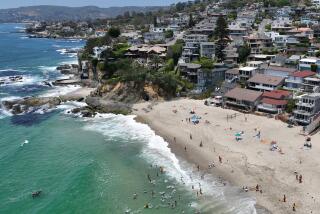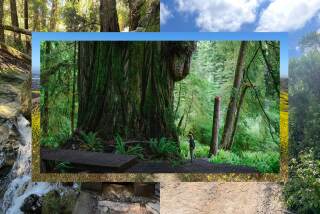San Onofre tollway fight will resume
Seven months after thousands poured into the Del Mar Fairgrounds for a raucous state Coastal Commission hearing on whether to build a 16-mile toll road through a state park in north San Diego County, both sides are set to be back at it today.
Repeat or not, the stakes remain high. Advocates say the toll road is critical to untangling freeway congestion across the region, while opponents contend it will be ruinous to one of the state’s most popular coastal parks and famed surf spots.
The latest round in the byzantine battle is a much-anticipated 10-hour appeal hearing before an attorney with the U.S. Department of Commerce. The Commerce secretary can override the February decision by the Coastal Commission to reject plans for the tollway.
Although the setting is familiar and the players much the same, today’s reunion won’t end with a dramatic decision -- Secretary Carlos M. Gutierrez has until January to announce his determination. And unlike February’s lively gathering that some disparaged as a circus, federal officials have instituted strict rules on who is allowed to speak, and for how long; banned booing and cheering; and limited the size of signs -- which can’t be waved -- to 2 feet wide.
Those restrictions notwithstanding, 657 people are registered to speak on the proposed turnpike, which has enraged environmentalists and rallied transportation planners from south Orange County to Washington, D.C.
What originated as a routine transportation scheme more than 20 years ago has mushroomed into an emotional debate about the demands of growth versus the importance of protecting parks.
“The impacts of this toll road project are monumental -- it’s hard to fathom how big they really are,” said Elizabeth Goldstein, president of the nonprofit California State Parks Foundation.
“This project has come to symbolize the threats that exist to our state parks,” she said. “Californians believe that when a park becomes a state park, that it’s protected forever. Despite that belief, this project has really brought into clear focus . . . that is not true.”
The issue has unleashed reams of competing legal opinions, government letters, scientific studies, opinion polls, advertisements and propaganda from both sides.
The six-lane, $1.3-billion extension of California 241 would connect Rancho Santa Margarita in south Orange County with Interstate 5 at Basilone Road in north San Diego County, slicing lengthwise through San Onofre State Beach. The Transportation Corridor Agencies -- the firm that runs Orange County’s tollways -- plus elected officials, including Gov. Arnold Schwarzenegger, contend that the proposed highway is vital to relieve growing gridlock on I-5.
“Folks from one end of the state to the other end of the state will use it,” said Jim Dahl, a San Clemente city councilman who sits on the transportation agency’s board of directors. “It’s not just an isolated backcountry roadway.”
Said Tustin Mayor Jerry Amante, who is the chairman of the board of directors: “It’s crucial to our southern region, it’s crucial to air quality, it’s crucial to public safety.”
Counters state Sen. Christine Kehoe (D-San Diego): “I don’t think it’s reasonable to think that California can build its way out of traffic congestion. We need to look at these problems in a new way. Once these roads are built, there’s really no going back.”
In addition to denouncing the project as destroying a popular state park, opponents say it would imperil endangered species and ruin land considered sacred by local Native American tribes.
“A park is not a developable thing,” said Bobby Shriver, a Santa Monica city councilman and former state parks commissioner who opposes the road.
One of the most publicized points of debate is whether sediment created by the road extension would harm the waves at the world-famous Trestles surf break, fed by San Mateo Creek. Scientific analyses commissioned by both sides disagree, but “Save Trestles” has become a rallying cry, galvanizing the surfing community against the tollway.
“It’s turned into a religion,” Dahl said of anti-toll road activism. “You’re either dead set against it or dead set for it.”
“You’ve got this small band of people who are zealots, who . . . wrap themselves up in the flag of surfing and scream and yell from the rooftops,” Amante said. “They’ve made it their Waterloo.”
At today’s hearing, Jane Luxton, general counsel for the National Oceanic and Atmospheric Administration, part of the Department of Commerce, is set to hear testimony from elected officials, organizations and members of the public. Gutierrez, the Commerce secretary, is to then consider that oral testimony, written comments and documents submitted by both sides in his decision. The public comment period remains open until Oct. 2.
Gutierrez can decide to override the state Coastal Commission’s decision if these three conditions are met:
The toll road significantly furthers the national interest.
The national benefits are greater than any adverse effects.
There is no reasonable alternative.
If they aren’t, the secretary could also override the state’s ruling if he finds that the toll road is necessary for national security.
Of the 42 coastal development appeals filed with the Department of Commerce since 1983, the federal government has overridden state decisions 14 times, five of those in California.
The fight over the road has resulted in a few political shenanigans. Schwarzenegger removed brother-in-law Shriver and film director Clint Eastwood from the state parks commission this year, dismissals they said were related to their vocal opposition to the toll road. Schwarzenegger’s office denies that claim.
Last month, the council that represents 130,000 unionized construction industry workers in Los Angeles and Orange counties urged the Surf Industry Manufacturers Assn. -- with such members as Quiksilver and Billabong -- to quit sponsoring toll road opponents’ “misinformation campaign.”
Although the debate over building the toll road has dragged on for decades, neither side shows signs of fatigue.
“The level of activism and engagement keeps rising,” said Goldstein, of the state parks foundation. “In a funny kind of way, I think the longer this goes on, the more frustrated people become that they’re unable to influence this process.”
And that frustration is pretty much guaranteed to continue: No matter what Gutierrez decides, the losing side can always appeal in federal court.
--
susannah.rosenblatt@latimes.com
More to Read
Sign up for Essential California
The most important California stories and recommendations in your inbox every morning.
You may occasionally receive promotional content from the Los Angeles Times.










